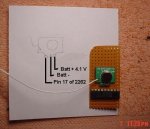I have a small transmitter that is part of a wireless motion sensor. THe markings on the transmitting side are 016-617tx-020r I cant find anything on it on the net. It has three connections going to the rest of the circuit. Two of which are joined by a tiny capacitor the third one isnt. Any ideas on how I can hack the transmitter without killing it?
Small rf transmitter ?
- Thread starter tmack
- Start date
Three legs, so the obvious guess is : 0V, +V and Input. I'd say it would also be a good guess that the capacitor goes across 0V and +V. The first thing to do is get a meter and measure continuity from any obvious looking 0V and +V lines to the transmitter, that should confirm the two power rails and which is which. Once you have 0V and +V identified, measure the voltage across those pins.
Ideally a scope on the lines referenced to 0V saves a lot of work and you'll quickly find what voltages it is working with.
Ideally a scope on the lines referenced to 0V saves a lot of work and you'll quickly find what voltages it is working with.
Now that's funny, we must be thinking about the same thing.
If the unit is a Driveway Alert, see if this helps:
If the unit is a Driveway Alert, see if this helps:
Attachments
-
30.1 KB Views: 132
The two terminals connected with the capacitors are the power terminals of the transmitter. One of them being ground and the other one being some positive voltage. The capacitors are connected with the power lines to reduce any noise. Now the third line is probably the signal in from the motion sensor. When movement is detected, the motion sensor sends a pulse or some sort of signal to the transmitter which it then transmits in the given bandwidth with the provided signal power. It's not a very complicated one in my opinion, seeing as it is a UHF transmitter
surface mount assembly
surface mount assembly
Last edited:

